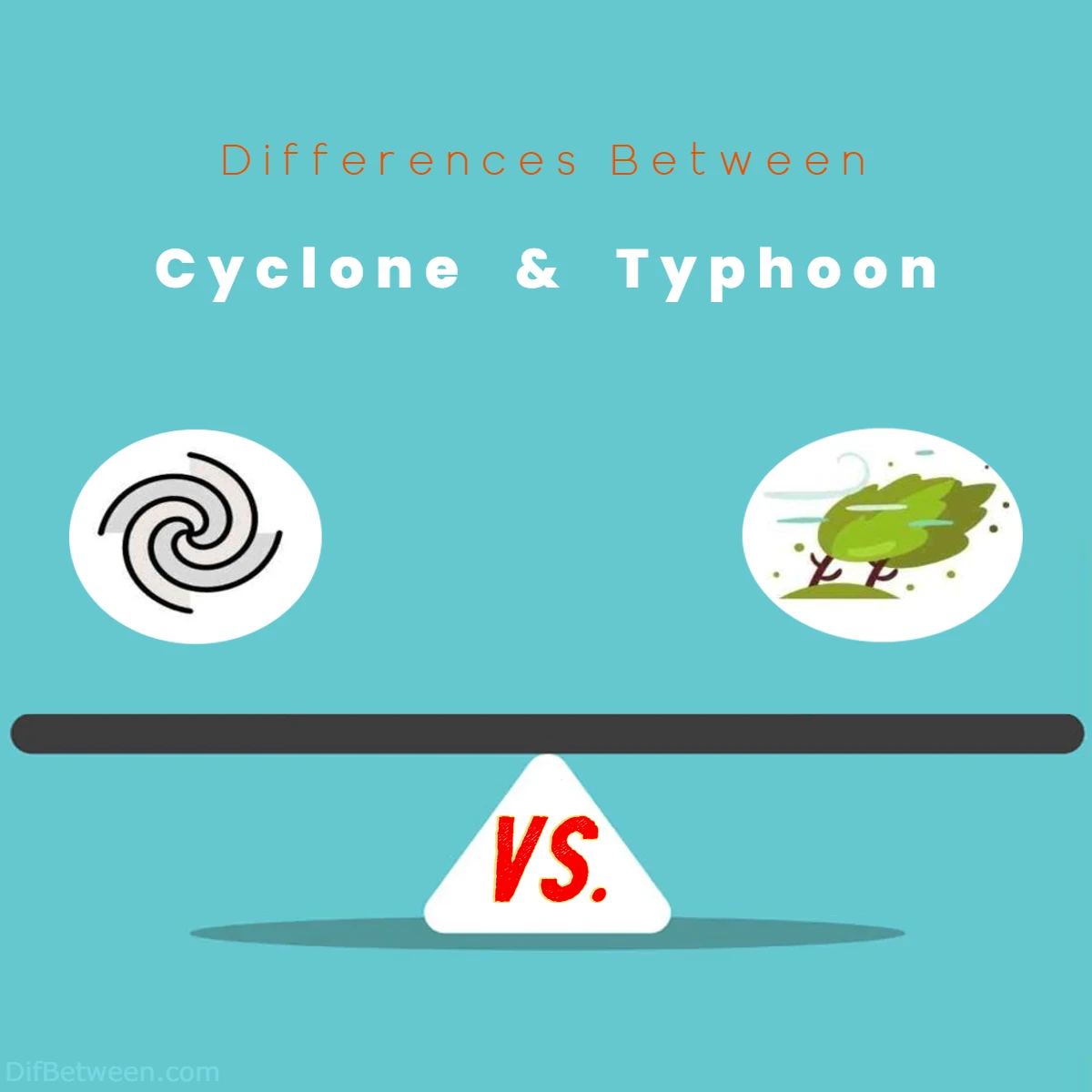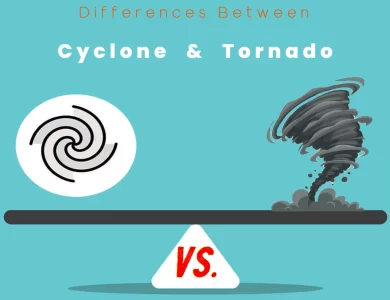
| Aspect | Cyclones | Typhoons |
|---|---|---|
| Definition | A broad term including various rotating low-pressure weather systems. Encompasses tropical cyclones, extratropical cyclones, and more. | A specific type of tropical cyclone occurring in the northwest Pacific Ocean. |
| Formation | Arise from warm ocean waters with surface temperatures above 26.5°C (80°F). Develop over tropical and subtropical regions. | Form over warm waters of the northwest Pacific Ocean, mainly between longitudes 180° and 100°E. |
| Global Locations | Found in multiple regions and ocean basins, including the Atlantic, Indian, and southern Pacific Oceans. | Exclusive to the northwest Pacific region, affecting countries like Japan, China, Taiwan, and the Philippines. |
| Naming Conventions | Named based on regional conventions, including predetermined lists of names. Can be given different names in different regions. | Names assigned by the Japan Meteorological Agency (JMA) in the northwest Pacific, often related to cultural elements. |
| Intensity Scales | Classified based on various scales such as the Saffir-Simpson Hurricane Wind Scale or regional equivalents. | Classified using the JMA’s intensity scale or, in some regions, the Saffir-Simpson scale. |
| Impacts | Can cause widespread damage, including strong winds, heavy rainfall, flooding, and storm surges. | Similar impacts to cyclones, concentrated in the northwest Pacific region. |
| Mitigation | Countries prone to cyclones have established disaster preparedness plans, early warning systems, and evacuation strategies. | Typhoon-prone nations have invested in resilient infrastructure and public education to enhance preparedness. |
| Climate Change | Climate change could influence cyclone behavior and impact through factors like warmer ocean waters and changing atmospheric conditions. | Climate change can affect typhoons similarly, with warmer sea surface temperatures potentially leading to more intense storms. |
| Frequency | Occur worldwide in various regions throughout the year. | Occur in the northwest Pacific region, generally during the typhoon season. |
Imagine a world where the atmosphere holds the reins, where winds spin stories, and clouds paint the sky with shades of drama. Our narrative unfolds with the word “cyclone” – a term that embraces a spectrum of rotating weather systems, ranging from tropical cyclones to extratropical ones. Now, let’s direct our gaze to the northwest Pacific, where a different protagonist emerges: the mighty typhoon. Residing exclusively in this region, typhoons are akin to the tropical cyclones that dance across warm ocean waters, but with their unique flair.
Differences Between Cyclone and Typhoon
The main differences between Cyclone and Typhoon lie in their geographical locations and nomenclature. Cyclone is a general term encompassing various rotating low-pressure weather systems, including tropical cyclones and extratropical cyclones, found in different regions globally. On the other hand, a Typhoon is a specific type of tropical cyclone that occurs exclusively in the northwest Pacific Ocean, affecting countries like Japan, China, Taiwan, and the Philippines. While both share common characteristics in their formation and impacts, the distinction arises from the region where they originate and the name assigned to them.
Defining Cyclones and Typhoons
Cyclones: The term “cyclone” is a comprehensive label encompassing a wide range of rotating low-pressure weather systems. Cyclones can be further classified into three main categories: tropical cyclones, extratropical cyclones, and mesocyclones. Among these, tropical cyclones are the ones that bear the closest resemblance to typhoons. They are characterized by their organized circulation patterns and form over warm ocean waters, gaining energy from the heat of the water.
Typhoons: A typhoon, on the other hand, is a specific type of tropical cyclone. The term is primarily used in the northwest Pacific region, especially in the western part of the Pacific Ocean. Typhoons are essentially identical to hurricanes and cyclones in terms of their characteristics—spiraling winds, low-pressure centers, and potent rainfalls. The distinction lies in the location where they originate and the nomenclature used by meteorologists and residents of various regions.
Formation and Nurturing
Cyclone Formation: Cyclones, in their various forms, arise from the atmosphere’s perpetual dance between warm and cold air masses. Tropical cyclones, the type relevant to our comparison, initiate over warm ocean waters with surface temperatures above 26.5°C (80°F). The warm air heats up the sea’s surface, causing moisture to rise and condense, subsequently forming towering clouds. These clouds begin to rotate due to the Earth’s Coriolis effect—the apparent deflection of moving objects caused by the Earth’s rotation. As the system gains momentum, a low-pressure center forms, and winds spiral towards it. This is the birth of a tropical cyclone.
Typhoon Formation: Typhoons are a subset of tropical cyclones and thus share a similar birth process. They typically emerge in the northwest Pacific Ocean, mainly between the longitudes of 180° and 100°E. The warm waters of this region provide the necessary energy for typhoon genesis. As moist air rises from the warm sea surface, it cools and condenses, releasing latent heat that further fuels the system’s development. The Coriolis effect, crucial for their rotation, comes into play as the nascent typhoon gains strength. It’s worth noting that while all typhoons are cyclones, not all cyclones are typhoons—this distinction rests on geography.
Global Locations and Nomenclature
Cyclone Distribution: Cyclones, in their broader classification, are found in multiple regions across the world. Extratropical cyclones, for instance, are prevalent in the middle latitudes and are responsible for much of the temperate weather variability. Mesocyclones, often associated with tornadoes, are common in areas with volatile weather conditions. Tropical cyclones, which include typhoons, are found in different ocean basins, each with its own naming conventions.
Typhoon Hotspot: Typhoons, as mentioned earlier, are exclusive to the northwest Pacific Ocean. This expansive region is a hotbed for typhoon formation due to its warm ocean temperatures, high humidity, and favorable wind patterns. Countries situated along the western Pacific coastline, such as Japan, China, Taiwan, and the Philippines, are particularly vulnerable to the impacts of these powerful storms. The northwestern Pacific is, indeed, the arena where typhoons showcase their breathtaking yet destructive performances.
Distinct Impacts
Cyclonic Destruction: Cyclones, irrespective of their specific type, can wreak havoc through a combination of factors. Intense winds, often exceeding 74 mph (119 km/h) in tropical cyclones, can uproot trees, damage infrastructure, and cause power outages. The accompanying heavy rainfall may lead to flooding, landslides, and erosion. Storm surges, the rise in sea level due to a storm’s winds and low pressure, can inundate coastal areas, resulting in catastrophic consequences. The broad reach of cyclones means that their impacts can extend far inland from the coastlines.
Typhoon Havoc: Typhoons, being a subset of tropical cyclones, share these destructive traits. However, due to their prevalence in the northwest Pacific region, their impacts are concentrated around those areas. For example, in Japan, typhoons are a regular occurrence, and the country has developed robust infrastructure and disaster preparedness measures to mitigate their effects. Nevertheless, typhoons can still cause widespread damage, disrupt transportation, and lead to loss of life.
omparing Intensity
Intensity of Cyclones: Cyclones exhibit a wide range of intensity, spanning from weak tropical depressions to powerful Category 5 hurricanes. The Saffir-Simpson Hurricane Wind Scale is often used to categorize cyclones based on sustained wind speeds. The scale classifies cyclones into five categories, with Category 1 being the least intense and Category 5 representing the most ferocious storms, boasting winds of 157 mph (252 km/h) or higher. The intensity of a cyclone can determine the potential damage it might cause, including wind-related destruction and flooding due to heavy rainfall.
Intensity of Typhoons: Typhoons, as a subset of tropical cyclones, adhere to similar intensity scales. The Japan Meteorological Agency (JMA) uses a different classification system, ranging from Category 1 to Category 5. In contrast, the United States’ National Hurricane Center employs the Saffir-Simpson scale. While the scales differ, the underlying principle remains consistent: to assess and communicate the potential impacts of the approaching typhoon based on its wind strength.
Mitigation and Preparedness
Cyclone Preparedness: Countries that are prone to cyclones, particularly tropical cyclones and hurricanes, have established sophisticated strategies to minimize damage and save lives. These strategies include early warning systems, evacuation plans, and building codes that ensure infrastructure can withstand cyclonic forces. Government agencies, meteorological organizations, and disaster response teams collaborate to track cyclones’ paths and issue timely warnings to residents and authorities. This proactive approach helps communities prepare for the impending onslaught of powerful winds and torrential rains.
Typhoon Mitigation: In the northwest Pacific, where typhoons frequently lash coastal areas, communities have embraced a culture of preparedness. Nations like Japan and the Philippines have invested heavily in infrastructure designed to withstand typhoons, such as sturdy buildings and advanced drainage systems. Furthermore, public education campaigns help residents understand the importance of evacuation orders and emergency kits. The cumulative effect of these efforts is a heightened resilience that enables communities to endure typhoons’ impacts with greater fortitude.
Climate Change and Future Trends
Cyclones in a Changing Climate: Climate change has cast a shadow of uncertainty over the future behavior of cyclones. While the relationship between climate change and the frequency of cyclones remains a topic of research, it’s widely agreed that warmer ocean waters can fuel more intense storms. Rising sea levels could amplify the impact of storm surges, making coastal areas more vulnerable. Additionally, changing atmospheric conditions could influence cyclone tracks and the regions they affect. Monitoring and understanding these potential shifts are essential for adapting to a changing climate.
Typhoons in a Changing Climate: Typhoons, being a subset of tropical cyclones, are also subject to the influences of a changing climate. Warmer sea surface temperatures, often associated with climate change, provide the energy needed for typhoon formation and intensification. While studies are ongoing to determine how typhoon behavior might evolve, it’s plausible that an increase in sea surface temperatures could result in more intense typhoons. This possibility underscores the importance of developing resilient infrastructure, disaster preparedness, and climate adaptation strategies in the typhoon-prone regions of the northwest Pacific.
FAQs
Cyclone is a broad term encompassing various rotating low-pressure weather systems, including tropical cyclones and extratropical cyclones, found in different regions globally. Typhoon, on the other hand, is a specific type of tropical cyclone that occurs exclusively in the northwest Pacific Ocean.
Cyclones and typhoons share similar impacts, including strong winds, heavy rainfall, flooding, and storm surges. However, typhoons’ impacts are concentrated in the northwest Pacific region, affecting countries like Japan, China, Taiwan, and the Philippines.
No, cyclones are a broader category, occurring in various regions and oceans, while typhoons are specific to the northwest Pacific Ocean. The term “typhoon” is used in this region, while other areas may use terms like “hurricane” or “cyclone.”
Yes, both cyclones and typhoons can be influenced by climate change. Warmer sea surface temperatures, associated with climate change, can provide the energy needed for their formation and intensification.
Cyclones and typhoons are named based on regional conventions. Cyclones’ names may be chosen from predetermined lists, while typhoon names are assigned by the Japan Meteorological Agency and often reflect cultural elements.
Yes, cyclones and typhoons can occur simultaneously in different regions of the world. Since they are both types of tropical cyclones, they may form in various ocean basins during the respective cyclone seasons.
Both cyclones and typhoons can vary in intensity, from weak systems to powerful storms. They are classified using different intensity scales, such as the Saffir-Simpson Hurricane Wind Scale or the Japan Meteorological Agency’s scale.
Communities prone to cyclones and typhoons can prepare by establishing disaster response plans, early warning systems, evacuation strategies, and resilient infrastructure to minimize damage and ensure public safety.
Research suggests that warmer ocean temperatures could lead to more intense cyclones and typhoons. Monitoring and understanding these trends are essential for adapting to a changing climate and enhancing disaster preparedness.
As our climate changes, the behavior and impacts of cyclones and typhoons could evolve. It’s crucial to stay informed about local weather forecasts, follow authorities’ instructions during storms, and support climate adaptation efforts.
Read More:
Contents






